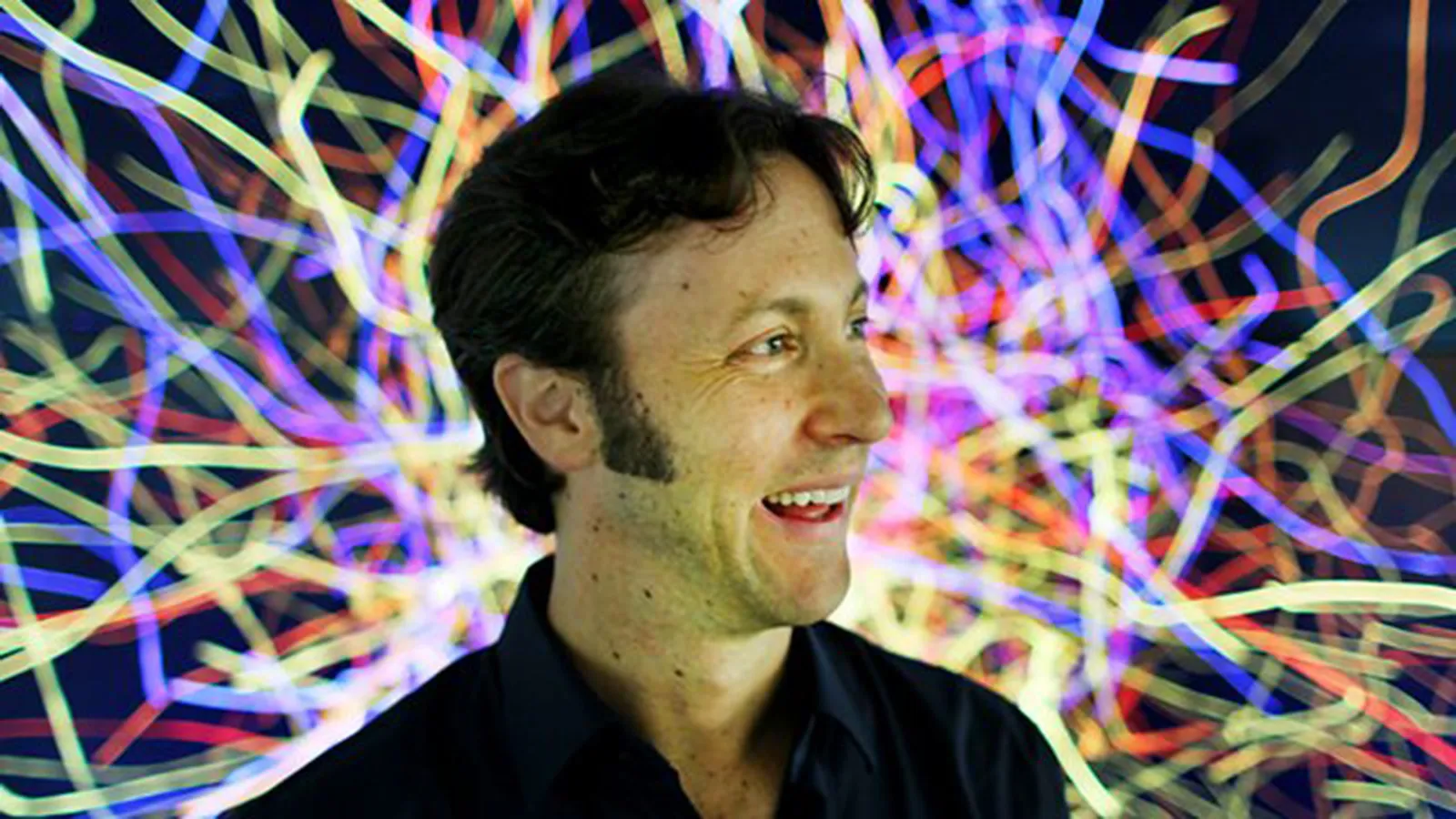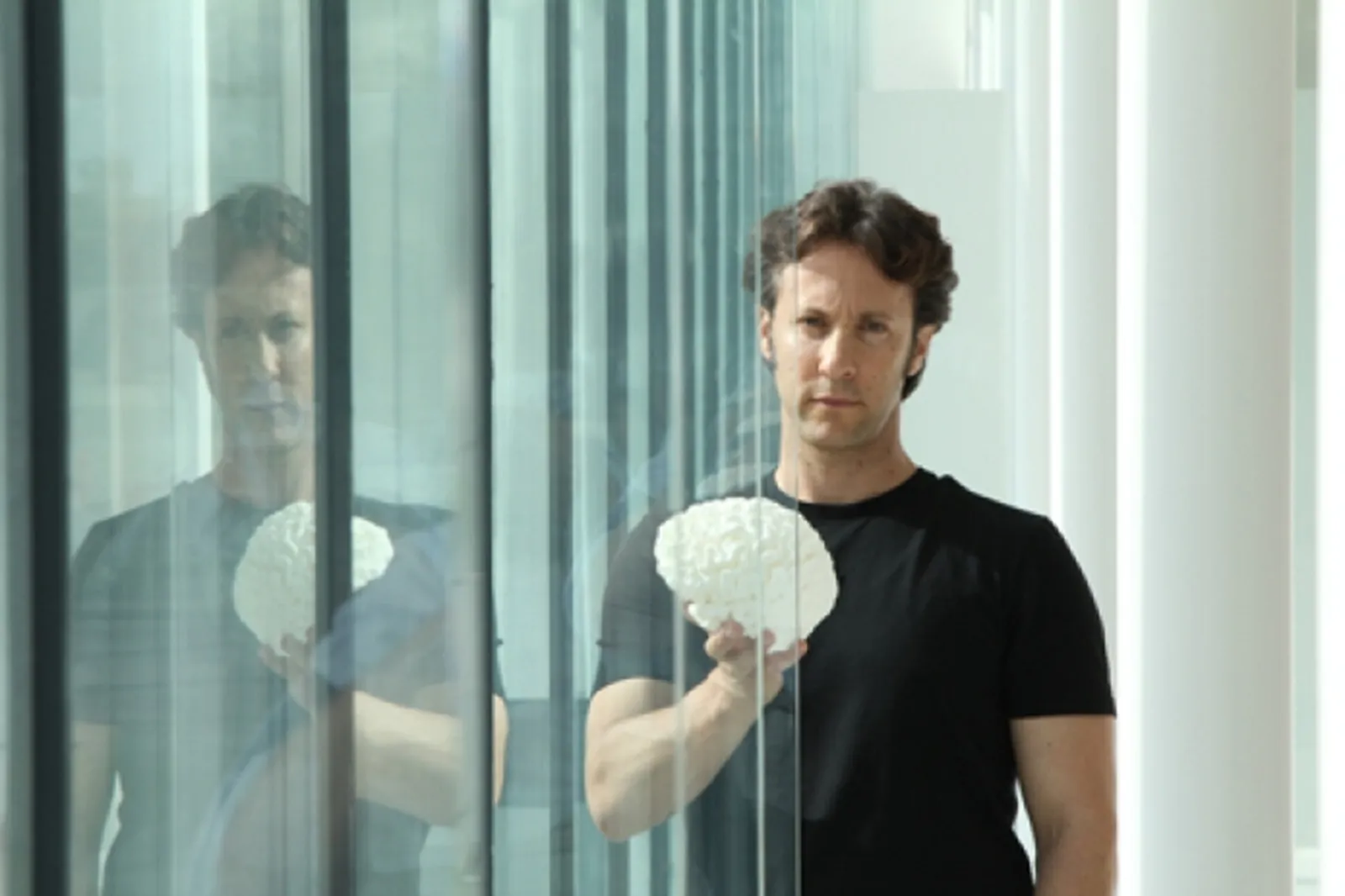David Eagleman: The True Superhero of Sensory Substitution
Why does time seem to slow down when we experience danger? This is a question that troubled David Eagleman ever since he took a fall as a young boy, and led him to study neuroscience as an adult in a quest for the answers. Now he’s looking at the way the brain processes other sensory information, and creating new ways for people to understand and interact with the world around them through revolutionary applications that can help everyone from the hard of hearing to drone pilots.

Emulating Alice in Albuquerque
David was born in 1971 in Albuquerque, New Mexico; his parents, Arthur and Cirel, worked as a doctor and a teacher in a small community nestled in the foothills of the Sandia Mountains. Growing up in this remote place had advantages and disadvantages, but David and his older brother Joel made the most of the opportunities for play that were available. One of these was a local construction site, a few miles from their home, and it was here that David had a life changing experience as an eight year old. He later described how he was exploring a half built house on the site when he placed his foot on what appeared to be a solid section of ledge overhanging what would later be a living room: “It looked stiff, so I stepped on it.”
"The brand new social experience where you activate your gaming skills as you train like a spy."
- TimeOut
Take on thrilling, high-energy espionage challenges across different game zones.

It turned out that the ledge was not stiff, and David plummeted to the floor, landing on his nose. It did not seem like plummeting to David at the time, however, and he felt he had a great deal of time to contemplate his fate as he made the journey to the lower floor. He would later describe the many clear recollections he has of his descent; reaching to grab the ledge but it being out of reach, noticing shiny nails scattered on the upper floor as he fell below it, and thinking to himself “this must be how Alice felt when she was tumbling down the rabbit hole” as his body rotated in mid-air and he drew closer to the ground below.
A nose for neuroscience
David’s nose took the brunt of the fall, and the damage was serious enough to require all of his nasal cartilage to be removed, but there was also a more important lasting impact on David: a fascination with temporal dilation. The experience never left him, but neuroscience did not immediately seem like something he wanted to study, and his ambition as a young man was originally to “write books”. His circuitous path to the laboratory began with an undergraduate degree in British and American Literature at Rice University, but he found himself unsatisfied with the subject. He dropped out for a while, joined the Israeli army for a year, and even moved to Los Angeles to try his hand at standup comedy. Eventually he returned to Rice, where he began to read books on neurolinguistics in his spare time and immediately realized this was what he wanted to study. “I was immediately enchanted just by the idea of it… here was this three-pound organ that was the seat of everything we are—our hopes and desires and our loves. They had me at page one.” He headed to grad school at Baylor University, and then the prestigious Salk Institute for his postgrad research, where he studied under Francis Crick, the Nobel laureate who had revealed the structure of the DNA molecule some forty years earlier. By the time Eagleman met him, in 1999, Crick was less interested in DNA and more in issues surrounding consciousness, and these also fascinated Eagleman. He set out to investigate the phenomenon of time dilation that he had experienced 20 years earlier.

He did this in a spectacular manner, assessing volunteers taking part in a SCAD jump. SCAD stands for Suspended Catch Air Device, which is a fancy way of saying “big net”. Jumpers climb a tower and then fall, without any safety attachments, into a giant net over a hundred feet below them. Eagleman saw this as the closest he could ethically get to recreating the dangerous circumstances of his own experience, and rigged a SCAD jump with timers. The jumper would be asked to assess how long they thought they were falling for, and the answer was always substantially longer than the actual duration of the fall, by an average of 36%. David had hoped that this would lead to evidence of increased temporal resolution - the brain perceiving time more rapidly - but frustratingly no evidence of this phenomenon occurred, and the faller’s perception was only distorted when recalling events. He later recalled words that Francis Crick had said to him before his passing in 2004 - “The dangerous man is the one who has only one idea, because then he’ll fight and die for it. The way real science goes is that you come up with lots of ideas, and most of them will be wrong.”
Sensory substitution
Fortunately, David had plenty of other ideas - enough to fill several bestselling books on a wide variety of subjects, including fiction writing - and one in particular has become an important focus for him since the disappointing results of the SCAD experiments. The concept of sensory substitution, where sensory information is converted into new formats that the brain can perceive, has been around since the 1980s, but David took the idea and ran with it, hypothesizing about a huge array of potential applications. He’s also developing a remarkable commercial product through his company, Neosensory, which illustrates the enormous potential of the idea; The Buzz is a wristband that uses haptic feedback to transmit auditory information to the user through vibrations that are picked up via the skin.
This works because of the way the brain assigns resources to processing sensory information. At first, a Buzz user will be able to recognise that the wristband is vibrating and - if they are able to hear - that those vibrations are attuned with the sounds in their environment. Over time, the brain will start to recognise this correlation on a deeper level, and devote more cognitive resources to interpreting the new signals as their relevance becomes more apparent, effectively training itself to make better use of this new sensory input. In 2022 Neosensory released a new product, Clarify, that operates on similar lines, but assists the hearing impaired with speech recognition.

Achieving Clarity
These are remarkable products, but Neosensory is dreaming bigger. The potential applications of sensory substitution are enormous, and David has been testing plenty of outlandish concepts and ideas which do not exclusively involve replacing one sense with another. For example, one potential application is to use vibrations to transmit flight data from drones, so human operators have sensory knowledge of the drone’s yaw, pitch and roll transmitted directly to their skin. Another, more practical application that David likes to reference is the possibility of having a user connected to a building’s data through vibrations, allowing janitors to more effectively and efficiently monitor vital information about the buildings under their care.
The future potential of these innovations is hard to estimate, but the real world benefits conferred by products such as Buzz and Clarity are easier to see (or, perhaps, feel). Francis Crick need not have worried about his pupil’s flexibility; this True Superhero’s endless stream of ideas is already yielding amazing results and helping people to overcome significant challenges, and it seems highly likely that there will be more to come in the near future.
SPYSCAPE+

Join now to get True Spies episodes early and ad-free every week, plus subscriber-only Debriefs and Q&As to bring you closer to your favorite spies and stories from the show. You’ll also get our exclusive series The Razumov Files and The Great James Bond Car Robbery!


Gadgets & Gifts
Explore a world of secrets together. Navigate through interactive exhibits and missions to discover your spy roles.
Your Spy Skills
We all have valuable spy skills - your mission is to discover yours. See if you have what it takes to be a secret agent, with our authentic spy skills evaluation* developed by a former Head of Training at British Intelligence. It's FREE so share & compare with friends now!
* Find more information about the scientific methods behind the evaluation here.


Stay Connected
Follow us for the latest
TIKTOK
INSTAGRAM
X
FACEBOOK
YOUTUBE